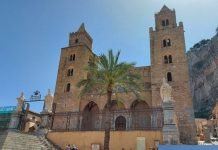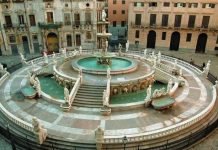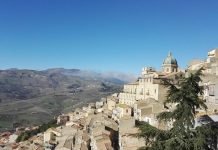
In this guide, we’ll take you on a walking tour of the Historic Center of Cefalù (Cefalù’s Old Town).
This leisurely stroll takes about two hours, allowing for stops at the main tourist attractions.
Indice
Historic Center of Cefalù: Walking Tour from Via Matteotti to Via Umberto I
A delightful walk through Cefalù’s Old Town naturally begins on Via Giacomo Matteotti, easily accessible from Via Roma, the main street of Cefalù.
The first charming sight you’ll notice is a small playground on your right, a space with slides and paths designed for children’s amusement.
Inside, you’ll also find several benches and, most importantly, a fountain with fresh, drinkable water.
Take advantage of it to let the kids play or to quench your thirst and refill your water bottles, as well as enjoy the coolness offered by the shade of the trees.
Opposite the playground, there’s a staircase that allows you to exit the historic center of Cefalù and descend towards the sea, if you wish.
Continue along Via Matteotti for about a hundred meters, and you’ll reach Piazza Garibaldi, where the Church of Maria Santissima della Catena stands out.
Built in 1780, it features an iconic round arch and Ionic capitals on the pillars.
Looking up, you’ll notice two beautiful clocks located just below the bell tower.
Right next to the steps leading to the church entrance, you’ll see a monument dedicated to Salvatore Spinuzza, a bust to be precise. It was here that the patriot was executed.
The rest of the square features a large number of bars and restaurants with outdoor seating, as well as an elegant Art Nouveau building right at the entrance to Via Umberto I.
Finally, this square also has a staircase that allows you to exit the historic center of Cefalù and head towards Cefalù’s beach.
Corso Ruggero: The Heart of Cefalù’s Historic Center
Resuming our walk within Cefalù’s Old Town, after passing the Church of Maria Santissima della Catena, the street takes the name of Corso Ruggero.

This is the most important street in Cefalù from a historical point of view, and it’s full of shops owned by entrepreneurs who have made the history of commerce in Cefalù (note: here is one of the access points to Cefalù’s Limited Traffic Zone!).
From clothing stores to jewelry shops, from leather goods to perfumeries, and local crafts, you’ll surely want to do some shopping while strolling here.
Vicolo Caracciolo, which you’ll notice on your right, is very characteristic: it’s a scenic staircase with very wide steps, which house colorful ceramic vases.
At number 86, you’ll find the Church of Maria Santissima dell’Annunziata, and right next to the church, you’ll find the Corte delle Stelle, a pink building used to host exhibitions, displays, and cultural activities in general.
Here, you can also admire a piece of ancient Roman flooring, discovered in the 1960s during the construction of the structure.
Just 20 meters further on, you can admire one of the lesser-known but most romantic and evocative squares in Cefalù: Piazza Giovanni Battista Spinola, enriched by the presence of the Church of Santo Stefano Protomartire del Purgatorio and the beautiful double staircase often adorned with colorful flowers.
The Baroque portal is also very beautiful, as are the two towers, one of which also serves as a bell tower. Let’s be clear, a nice souvenir photo here is a must!
Continuing along Corso Re Ruggero, take the opportunity to notice the various restaurants with tables on the street that characterize all the side streets towards the sea.
Some of these have really good food, others are a bit “touristy.” Always check reviews beforehand to avoid unpleasant surprises.
Piazza Duomo: The Icon of Cefalù’s Historic Center
A few more steps and you’ll finally arrive at the famous Piazza Duomo of Cefalù, which you’ve probably seen countless times in photographs.

The Duomo is sure to catch your eye from the first moment: take all the time you want and admire it from afar before you get closer. Certain details, in fact, can only be noticed at a certain distance and by contemplating the Duomo as a whole.
First of all, a note about the square: you’ll certainly notice the tall palm trees that make the environment even more evocative and a bit exotic, as well as the numerous café tables where you can taste a good granita or our typical sweets, as well as some types of Sicilian street food.
Right in front of the Duomo is the current seat of the Municipality of Cefalù, the Town Hall: you’ll easily recognize it as the Italian flag, the Sicilian flag, and the EU flag are always prominently displayed.

To the right of the Town Hall, we can admire Palazzo Pirajno (or directly Palazzo Piraino), built at the end of the 16th century and now owned by the noble family of the Barons of Mandralisca.
Now it’s time to focus all your attention on the Cefalù Cathedral: we’ve delved into historical and architectural aspects at the beginning of this article, now visit it calmly and try to access the Canonical cloister as well, you’ll see that it will be worth it.
Clearly remember that this is a sacred place: for this reason, there is a sign at the entrance inviting people to enter with appropriate attire. You can use the large scarves that are provided free of charge at the entrance.
After visiting the Duomo, you can resume your walk along Corso Ruggero: this stretch is probably the most “touristy” in Cefalù, and for this reason, souvenir shops and businesses offering local crafts abound here.

The shops selling Sicilian ceramics are very interesting, for example: consider that we are just a few kilometers from Santo Stefano di Camastra, a town historically engaged in the processing of ceramics.
The Bastion of Capo Marchiafava
When you reach the end of Corso Ruggero, turn left onto Via Carlo Ortolani di Bordonaro, another delightful little street that features interesting shops and some good restaurants with terraces overlooking the sea of Cefalù.

After about twenty meters, you’ll notice a small, entirely pedestrian street on your right, often enriched by the presence of restaurant and bar tables. It’s called “Piazza Francesco Crispi“: enter and walk along it.

On your right, you’ll notice a religious building, it’s the Church of Santa Maria dell’Odigitria and San Giovanni Evangelista (commonly called “Chiesa dell’Itria“).
It’s actually two adjacent churches, that of San Giovanni Evangelista and that of Santa Maria dell’Odigitria, which were united into a single parish in 1961.
Are you ready now to see something magnificent? Climb the stairs that are next to the church, you are about to go up the Bastion of Capo Marchiafava!
This is the highest point of the walls surrounding Cefalù, and it’s a polygonal-shaped base in an exceptional position to see the sea and the horizon, as well as the entire Gulf of Cefalù.




Here you can clearly take all the time you want to take beautiful pictures and enjoy the view, look at the cliff, admire the sunset, see the Cefalù lighthouse on your right, and see the Aeolian Islands in the distance when the weather conditions allow it.
Among other things, this is one of the two entry points for the Cefalù Cliff Path. Just go down a few steps, in fact, to access this platform on the rocks that literally runs along the sea for a few hundred meters.
If you access from here, you can exit directly at the bottom of the platform, exactly in front of the Old Port of Cefalù.
After visiting the bastion, resume your walk on Via Carlo Ortolani di Bordonaro: consider that many of the restaurants on this street have a terrace inside that overlooks the sea. If you want to have dinner here, book in advance and request one of the tables with a sea view.
The Old Port of Cefalù
When you reach the end of the road, you’ll see the sea in front of you, that’s the Old Port of Cefalù.

There’s a nice sandy beach here, not very big, where many people sunbathe and swim in the summer. Walking on the pier is also a fantastic experience: if you get to the very tip, in fact, you can enjoy a beautiful view of the beach and the nearby houses.
It’s a “postcard” that you’ve probably already seen many times on the web, it’s a fantastic point to take beautiful photos, especially at sunset when everything is red colored.

If you pass by the old pier on August 6th, you’ll see the famous “Ntinna a mari” of Cefalù: an ancient game that takes place during the feast of SS. Salvatore. It’s a long fir trunk suspended over the sea and soaped up properly. Whoever manages to walk in balance and take the flag placed at its end, wins.
Speaking of sunset, at the Old Port there is a staircase: climb it and you will find yourself on top of the wall, there is a stretch of about 20 meters that you can walk along that allows you to see the endless sea in front of you.
Here in summer, you can see the sun “go out” into the sea at sunset, roughly between 8:00 PM and 8:15 PM. Seeing the sunset here is absolutely one of the things to do in Cefalù!
Via Vittorio Emanuele
After your visit to the port, you can continue your walk by entering Via Vittorio Emanuele: immediately on your right, you’ll notice the famous “Porta Pescara” (also called “Porta del Vicerè” or “Porta Marina“), one of the gates that once allowed entry into Cefalù.

Through the gate, you can see the sea and the beach, and with a little imagination, you can take beautiful photos here too.
The Ancient Medieval Wash House of Cefalù



Among the many attractions that you can find in the center of Cefalù, the ancient medieval wash house is certainly one of the most iconic.
This evocative place is located on Via Vittorio Emanuele between numbers 55 and 57 (the exact address is called “Discesa Fiume“).
The wash house that we can admire today was built in 1514 on the ruins of the oldest wash house, which was demolished precisely to allow the construction of the new one.
To access it, you need to go down a staircase of about 20 steps; unfortunately, it’s not accessible by wheelchair or with strollers.
It’s a semicircular environment created by digging into the bare rock, in which there are 15 basins of lava stone of different shapes and sizes, with wrought iron spouts to allow water to pass from one basin to another.
All the basins are therefore “connected” to each other through a network of channels, whose purpose is to allow wastewater to reach the sea.
Here, visitors will have the immediate perception of having gone back in time, when the local women went there to wash clothes and chat or confide secrets away from prying ears.
Moreover, given the nature of the place and the presence of water, after walking down the stairs, you will immediately feel a pleasant coolness.
If you decide to visit Cefalù on a particularly hot and humid day, make sure to visit the ancient medieval wash house during the hottest part of the day to enjoy its certainly pleasant microclimate.
The visit to the ancient medieval wash house of Cefalù is free, and the site is open every day from 10:00 to 12:00 and from 16:00 to 19:00 (in summer these hours are generally extended, it opens earlier and closes later).
After visiting the ancient Medieval wash house, walk to the end of Via Vittorio Emanuele and at the small square, follow the small street on the right, which takes you back to the Lungomare Giardina.
This concludes the tour of the historic center of Cefalù that we recommend you do.
You are doing well to book accommodation in the area, so you can walk to this area and the nearby promenade, full of pubs and restaurants.




